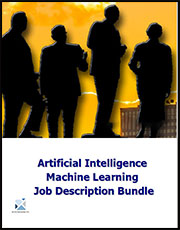Roadmap on Implementing DR/BC Plans with Artificial Intelligence
Using AI in Disater Recovery and Business Conitinuity Planning
AI can significantly enhance Disaster Recovery (DR) and Business Continuity (BC) plans by automating processes, improving prediction, and optimizing responses to disruptions. AI-powered tools can automate incident analysis, predict hardware failures, and accelerate recovery efforts. They can also improve risk assessment, identify potential vulnerabilities, and streamline documentation.
Here's how AI can be integrated into DRP and BCP plans:
Predictive Analytics and Risk Assessment
AI can assist with risk assessment, incident response, resource allocation, and communication during disruptions. AI-powered tools can analyze data, identify potential threats, and suggest optimal recovery strategies.
- Identifying Anomalies - AI algorithms can analyze historical data, system logs, and real-time sensor data to identify anomalies and potential failure points before they escalate into major disruptions.
- Predicting Failures - AI can predict when equipment is likely to fail, allowing for proactive maintenance and preventing downtime.
- Simulating Scenarios - AI can simulate various disaster scenarios and test the effectiveness of BCP plans, identifying weaknesses and areas for improvement.
- Assessing Third-Party Risks - AI can analyze data from third-party vendors to identify potential vulnerabilities and dependencies that could impact business continuity.
Read on Order Disaster Plan Template Sample DRP
Automated Incident Analysis and Response
Automated Incident Response
AI systems can analyze incidents, identify root causes, and trigger pre-defined recovery actions, potentially reducing the need for manual intervention and speeding up recovery.
Disaster Recovery (DRP)
- Automated failover and failback - Automated systems can detect failures and automatically switch to backup systems or sites, minimizing downtime and data loss.
- Rapid data recovery - Automated tools can quickly restore data from backups, ensuring minimal disruption to operations.
- Automated infrastructure provisioning - Systems can automatically provision necessary IT infrastructure in a secondary site, enabling faster recovery of critical systems.
Business Continuity Plan (BCP)
- Proactive risk identification - AI-powered systems can analyze data to identify potential threats and vulnerabilities before they escalate into major incidents.
- Real-time monitoring and alerting - Automated systems monitor critical systems and alert relevant personnel to potential issues, enabling a faster response.
- Automated execution of BC plans - Automated systems can trigger specific actions outlined in the BC plan, such as redirecting communication channels or activating alternative work arrangements.
- Continuous improvement of BC plans - By analyzing incident data, automated systems can identify areas where the BC plan can be improved and updated, ensuring its effectiveness over time.
Key benefits of automated incident response in DRP and BCP
- Faster response times - Automated systems can detect and respond to incidents much faster than manual processes, minimizing downtime.
- Reduced human error - Automation reduces the risk of human error, which can be a significant factor in prolonged downtime.
- Improved efficiency - Automated processes streamline the incident response and recovery process, making it more efficient and cost-effective.
- Better resource allocation - By automating routine tasks, organizations can free up valuable resources to focus on more complex issues.
- Enhanced resilience - Automated incident response strengthens overall resilience by enabling faster recovery and minimizing the impact of disruptions.
Anomaly Detection
AI can monitor system health, predict hardware failures, and detect unusual network activity, allowing for proactive measures to prevent disruptions. Anomaly detection can identify unusual patterns or deviations from normal operations that could indicate potential disruptions or security breaches. This proactive approach enables organizations to mitigate risks, respond effectively to incidents, and minimize downtime.
Enhancing Incident Response
- Real-time monitoring - Anomaly detection systems continuously monitor various aspects of the IT infrastructure, including network traffic, user behavior, and system performance.
- Early warning system - By identifying unusual patterns, anomaly detection can serve as an early warning system for potential security threats, such as unauthorized access attempts, data breaches, or malware infections.
- Faster incident response - With timely alerts, organizations can initiate incident response procedures more quickly, minimizing the impact of the disruption.
Improving Disaster Recovery
- Pre-emptive identification of issues - Anomaly detection can identify potential hardware or software failures before they escalate into major incidents, allowing for proactive maintenance and preventing downtime.
- Optimizing recovery processes - By analyzing system behavior during normal operations, anomaly detection can help identify bottlenecks or inefficiencies in the recovery process, enabling organizations to optimize their DRP plans and reduce recovery time.
- Validating recovery - Anomaly detection can be used to validate the successful recovery of systems and data after a disaster, ensuring that the organization can resume normal operations as quickly as possible.
Strengthening Security Posture
- Identifying security threats - Anomaly detection can be used to identify a wide range of security threats, including insider threats, malware infections, and network intrusions.
- Reducing the attack surface - By identifying and mitigating security risks early on, anomaly detection can help reduce the overall attack surface of the organization.
- Improving security awareness - By providing insights into potential security threats, anomaly detection can help raise awareness among employees and improve overall security practices.
Examples of Anomaly Detection in DR/BCP
- Network traffic analysis - Detecting unusual spikes in network traffic, unusual data transfers, or traffic patterns indicative of a DDoS attack.
- User behavior monitoring - Identifying unusual login attempts, access to sensitive data, or deviations from established user activity patterns.
- System performance monitoring - Detecting unusual resource utilization, performance degradation, or errors that could indicate hardware or software failures.
- Security log analysis - Identifying suspicious log entries that could indicate security breaches or policy violations.
Key Techniques
- Statistical methods - Analyzing data distributions and identifying outliers based on statistical properties.
- Machine learning - Training models on historical data to identify patterns and detect deviations from the norm.
- Deep learning - Utilizing neural networks to analyze complex data patterns and identify anomalies.
- By integrating anomaly detection into DRP and BCP plans, organizations can significantly enhance their ability to prevent, detect, and respond to disruptions, ensuring business continuity and minimizing potential losses.
Cybersecurity Enhancement
AI can be used to detect and respond to cyber threats, which are a major cause of IT-related disasters. Cybersecurity must be an integral part of Disaster Recovery (DR) and Business Continuity Planning (BCP) to ensure operational resilience in the face of cyberattacks. Integrating cybersecurity into these plans helps organizations minimize downtime, protect sensitive data, and recover critical systems effectively. This holistic approach involves assessing cyber risks, implementing robust security measures, and regularly testing and updating plans.
Key Areas of Cybersecurity Enhancement in DRP and BCP
- Cybersecurity Risk Assessment - Identify potential cyber threats and vulnerabilities that could disrupt business operations.
- Security Controls Implementation - Implement measures like strong passwords, multi-factor authentication, and endpoint protection to minimize attack surfaces.
- Data Protection - Safeguard sensitive data through encryption, regular backups, and secure storage solutions.
- Incident Response Planning - Develop a comprehensive plan for detecting, containing, eradicating, and recovering from cyber incidents.
- Business Impact Analysis - Assess the potential impact of a cyberattack on critical business functions and prioritize recovery efforts accordingly.
- Regular Testing and Training - Conduct drills and simulations to validate the effectiveness of DRP and BCP plans and ensure staff are prepared.
- Employee Training - Educate employees about cybersecurity best practices and their role in maintaining a secure environment.
- Continuous Monitoring and Improvement - Implement tools and processes for continuous monitoring of systems and adapt plans accordingly based on emerging threats and new technologies.
- Integration with other IT Security Plans - Align DRP/BCP with other security frameworks and initiatives, such as Zero Trust Architecture.
Read on Order Disaster Plan Template Sample DRP
Enhanced Risk Assessment and Prediction
Predictive Analytics
Predictive analytics plays a crucial role in enhancing both disaster recovery (DR) and business continuity (BC) strategies by leveraging data to anticipate potential crises and optimize response efforts. It helps organizations move from reactive to proactive approaches, improving their ability to minimize disruptions and ensure operational resilience. AI algorithms can analyze vast amounts of data to predict potential failures, identify vulnerabilities, and forecast the impact of various disruptions, enabling proactive risk mitigation.
- Early Warning Systems - Predictive analytics utilizes historical data, real-time information (like weather reports, social media, and sensor data), and advanced algorithms to identify potential threats before they escalate into full-blown disasters. This allows organizations to implement preventative measures and prepare for potential disruptions, minimizing damage and downtime.
- Resource Allocation Optimization - By analyzing data patterns and predicting the potential impact of a disaster, predictive analytics can help organizations optimize the allocation of resources (personnel, equipment, etc.) to areas most affected, ensuring a more efficient and effective response.
- Scenario Planning and Simulation - Predictive analytics can be used to simulate various disaster scenarios, allowing organizations to test their DR and BC plans, identify vulnerabilities, and refine their strategies before an actual event occurs.
- Recovery Time Objective (RTO) and Recovery Point Objective (RPO) Optimization - Predictive analytics can help organizations better understand the potential impact of different disaster scenarios on their systems and data, allowing them to set more realistic and achievable RTOs and RPOs.
- Improved Decision-Making - By providing data-driven insights and predictions, predictive analytics empowers organizations to make more informed decisions during a crisis, leading to faster and more effective responses.
Examples of Predictive Analytics in DRP/BCP
- Natural Disasters - Analyzing weather patterns, historical flood data, and seismic activity to predict potential floods, hurricanes, or earthquakes, and implementing preventative measures like evacuation plans or infrastructure reinforcement.
- Cyberattacks -Identifying suspicious network activity, detecting malware patterns, and predicting potential cyberattacks based on historical attack data and real-time threat intelligence.
- Supply Chain Disruptions - Analyzing global trade patterns, transportation networks, and supplier data to predict potential supply chain disruptions and implement alternative sourcing strategies.
- Power Outages - Using predictive models to forecast potential power grid failures based on weather patterns, equipment performance, and historical outage data, allowing for proactive maintenance and backup power activation.
Business Impact Analysis
AI can assist in documenting business relationships, identifying potential impacts, and highlighting critical vulnerabilities during a BIA.
- Identifying Critical Processes -Determining which business functions are essential for maintaining operations and meeting objectives.
- Assessing Impacts - Evaluating the potential financial, operational, and reputational consequences of disruptions.
- Prioritizing Recovery - Ranking the criticality of different processes to guide recovery efforts and resource allocation.
Streamlined Recovery and Optimization
AI can analyze data to predict potential failures, automate data recovery processes, and streamline communication during a crisis, leading to faster and more effective recovery.
Faster Recovery
AI can expedite data and service restoration by identifying the most critical systems for immediate recovery and automating failover processes. AI can analyze vast datasets to identify patterns indicative of potential issues, enabling
Predictive Failure Analysis
- Identify Anomalies - AI algorithms can analyze system logs, network traffic, and application performance data to detect anomalies that might indicate an impending failure.
- Predictive Maintenance - By analyzing historical data, AI can predict when components are likely to fail, allowing for proactive maintenance and preventing downtime.
- Early Warning Systems - AI-powered systems can provide early warnings of potential issues, giving IT teams time to address problems before they escalate into major disruptions.
Automated Recovery Processes
- Automated Failover - AI can automate the process of failing over to a secondary system, minimizing downtime during a disaster.
- Automated Resource Allocation - AI can dynamically allocate resources to critical systems during recovery, optimizing performance and ensuring business continuity.
- Automated Data Replication and Synchronization - AI can automate the process of replicating and synchronizing data to ensure that the secondary system has the latest data available.
Optimized Recovery Strategies
- Scenario Planning - AI can simulate different disaster scenarios and identify the most effective recovery strategies for each situation.
- Resource Optimization - AI can optimize the allocation of resources during recovery, ensuring that critical systems are prioritized and restored quickly.
- Dynamic Adjustments - AI can dynamically adjust recovery plans based on changing conditions, ensuring that the most efficient path to recovery is always followed.
Enhancing BCP Development
- Risk Assessment: - AI can analyze various data sources to identify potential business risks and vulnerabilities, helping to create a more comprehensive BCP.
- Impact Analysis - AI can assess the potential impact of different disruptions on business operations, allowing for better prioritization of recovery efforts.
- Training and Simulation - AI can be used to create realistic simulations of disaster scenarios for training purposes, improving the effectiveness of the BCP.
Resource Optimization
AI can help manage resources like bandwidth, storage, and compute power during a disruption, ensuring optimal allocation based on business needs.
Predictive Analytics and Risk Assessment
- Identifying potential risks - AI algorithms can analyze vast amounts of data (historical data, real-time sensor data, external sources) to identify potential vulnerabilities and predict possible disruptions.
- Assessing business impact - By analyzing the potential impact of various scenarios, AI can help prioritize recovery efforts and allocate resources accordingly.
Resource Allocation and Optimization
- Dynamic resource allocation - AI can automatically adjust resource allocation in real-time based on changing needs during a disaster, optimizing the use of available resources.
- Automated task assignment - AI can intelligently assign tasks to available personnel based on their skills and availability, ensuring efficient workload distribution.
Enhanced Communication and Collaboration:
- Automated communication - AI can streamline communication during a crisis by automatically notifying relevant personnel and stakeholders, ensuring everyone is informed and coordinated.
- Centralized information hub - AI can create a centralized platform for all recovery-related information, making it easily accessible to all team members.
Automated Testing and Simulation:
- Automated testing - AI can automate DR and BCP testing procedures, ensuring that plans are regularly validated and updated.
- Simulations -AI can simulate various disaster scenarios to identify weaknesses and optimize recovery strategies.
Cost Optimization:
- Reduced downtime - By optimizing resource allocation and improving recovery time, AI can minimize downtime and associated costs.
- Efficient resource utilization - AI can identify areas where resources can be consolidated or eliminated, leading to cost savings.
Read on Order Disaster Plan Template Sample DRP
Plan Optimization
AI can analyze past incidents and exercise data to refine BCPs, identify areas for improvement, and ensure the plan remains robust and adaptable.
Risk Assessment and Prediction
- Predictive Analytics - Predictive analytics in business continuity planning involves using historical data and statistical modeling to forecast potential disruptions and their impact, enabling organizations to proactively prepare and mitigate risks. By analyzing past trends and patterns, businesses can anticipate future challenges and implement strategies to minimize downtime and maintain operational resilience.
- AI algorithms can analyze historical data, system logs, and external threat intelligence to predict potential failures in IT infrastructure, supply chains, or other critical areas.
- Anomaly Detection: - AI can identify unusual patterns or deviations from normal behavior that might indicate an impending problem, allowing for proactive intervention.
- Risk Prioritization - AI can help prioritize risks based on their potential impact and likelihood of occurrence, enabling businesses to focus their resources on the most critical areas.
Automated Plan Generation
AI can assist in generating and updating BCP and DRP documents by analyzing business processes and identifying potential vulnerabilities.
- Resource Allocation: - AI can optimize the allocation of resources (personnel, equipment, etc.) during a disaster, ensuring that critical functions are prioritized and supported.
- Scenario Planning - AI can simulate various disaster scenarios and assess the effectiveness of different response strategies, allowing businesses to refine their plans and improve their readiness.
Enhanced Response and Recovery
- Real-time Monitoring - AI-powered monitoring systems can track the progress of recovery efforts and provide real-time updates to stakeholders.
- Automated Communication - AI can automate communication with employees, customers, and partners during a disaster, ensuring that everyone is informed and aware of the situation.
- Rapid Recovery - AI can accelerate the recovery process by automating tasks such as data restoration, system reconfiguration, and application deployment.
Continuous Improvement:
- Post-Incident Analysis - AI can analyze the effectiveness of the DR and BCP plans after a disaster, identifying areas for improvement and updating the plans accordingly.
- Feedback Loop - AI can incorporate feedback from employees and stakeholders to refine the plans and ensure that they are relevant and effective.
Improved Communication and Training
AI-powered chatbots
These can provide real-time support to customers and employees during a crisis, minimizing confusion and streamlining communication.
Automated Notifications
.AI can trigger alerts and notifications to relevant personnel, ensuring timely dissemination of information and coordinated response efforts.
Enhanced Training
AI can be integrated into training simulations to introduce new scenarios, evaluate response effectiveness, and build competence in handling disruptions.
Support for Human Decision-Making
Enhanced Decision-Making
AI can provide business leaders with timely and accurate information, enabling them to make informed decisions during a crisis.
Focus on Strategic Activities
By automating routine tasks, AI allows BC practitioners to focus on higher-level activities like strategic planning and decision-making.
By incorporating AI into DRP and BCP plans, organizations can significantly improve their resilience, minimize the impact of disruptions, and ensure business continuity in the face of unforeseen challenges.
Read on Order Disaster Plan Template Sample DRP







